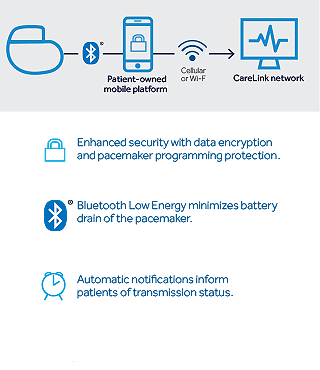This segment will review Frequently Asked Questions
1. What does the MyCareLink Heart Mobile App do?
The patient's smartphone replaces the bedside monitor to transfer heart device data from anywhere - even outside the home.

2. What are the top security measures for BlueSync technology?
Programming of the pacemaker
- Pacemaker doesn't accept programming from unauthorized sources. It can only have therapy programmed by a trained health care professional using the Medtronic 2090 or Encore™ programmer
- Device not connected to InternetPacemaker does not have an IP address, unlike connected consumer products
Data Privacy
- End-to-end EncryptionData is encrypted in the pacemaker using NIST* government standard for security (used in critical applications like banking) before it is transmitted to CareLink™ via the monitor
*NIST: National Institute of Standards and Technology
3. If the phone/tablet is stolen, what will someone see in the app?
Just like other apps, if the phone/tablet has Wi-Fi or cellular connection, the data on the app will be available on the phone or tablet for a viewer to see. We recommend protecting the phone/tablet with a PIN code, swipe gesture, or fingerprint. Also like other apps, the "remote wipe" feature will also delete MCL Heart app.
4. What phones and tablets will be compatible?
Some Apple® smartphones and tablets and Android phones are compatible.
Please see MCLHeart.com for latest list of compatible devices.
5. Can multiple patients use the same phone/tablet?
No, the patient’s device must be paired with MCL Heart app to be able to send an alert or a transmission. MCL Heart app does not look for multiple devices.
6. Can a patient log in to MCL Heart app on multiple phones/tablets?
Yes.
7. Is the app available in other languages than English?
Yes, 10 other languages. The language can be changed within the user's phone/tablet settings. If the user's phone is not set to one of the 11 languages, the MCL Heart app will display in English.
8. What are the requirements for using the app for remote monitoring?
Encourage patient to have the phone with them as much as possible throughout the day (minimum of 3 consecutive hours per day)*:
- Phone/tablet ON
- Bluetooth ON in settings
- App open in background†
- Phone/tablet within 3 feet (1 m) of pacemaker
- Phone/tablet has Internet or cellular or Wi-Fi connectivity
* Keeping your phone or tablet close to you for 3 continuous hours helps ensure that the app communicates with your heart device and that your heart device data is successfully sent to the Medtronic CareLink™ Network. Communicating with your heart device can take 5 to 15 minutes. The communication between the app and your heart device can be interrupted if your phone or tablet is not near you (within 3 feet or 1 meter). Sending your heart device's data to the Medtronic CareLink™ Network can take between 3 to 24 hours. Your data may not be successfully sent to the Medtronic CareLink™ Network if your phone or tablet is not near you (within 3 feet or 1 meter).
†The app can also be in the foreground.
9. What will happen if these requirements for use are not met?
After 4 days without communication between the app and the pacemaker or the app and CareLink, the patient will receive a push notification (or text or email if enabled in App Settings) with instructions on how to reconnect. If patient opens the app during that time, they will not see the tiles. Instead, there will be a popup prompting them to resolve the specific connectivity issue.
10. Will Bluetooth telemetry drain the pacemaker's battery?
Yes. Like any telemetry, Bluetooth Low Energy telemetry uses the battery of the heart device. However, Azure and Percepta have same or better longevity than other non-wireless Medtronic pacemakers/CRT-Ps.
11. Will others be able to use the pacemaker's Bluetooth?
The pacemaker Bluetooth does not allow for others to pair with, successfully communicate to, or view a patient’s pacemaker information.
12. Will the pacemaker interact with a car's Bluetooth functionality?
Automobiles typically use Bluetooth Classic (BT). The AzureTM/PerceptaTM devices use Bluetooth Low Energy (BLE) and are not compatible with BT. The car will not attempt to establish a connection with the pacemaker, and the pacemaker won't be able to detect BT transmissions.
Communication to Azure and Percepta pacemakers is accepted only from Medtronic apps and CareLink monitor. While the BLE protocol allows any mobile device to connect, the Azure pacemaker will drop any traffic not initiated by Medtronic.

